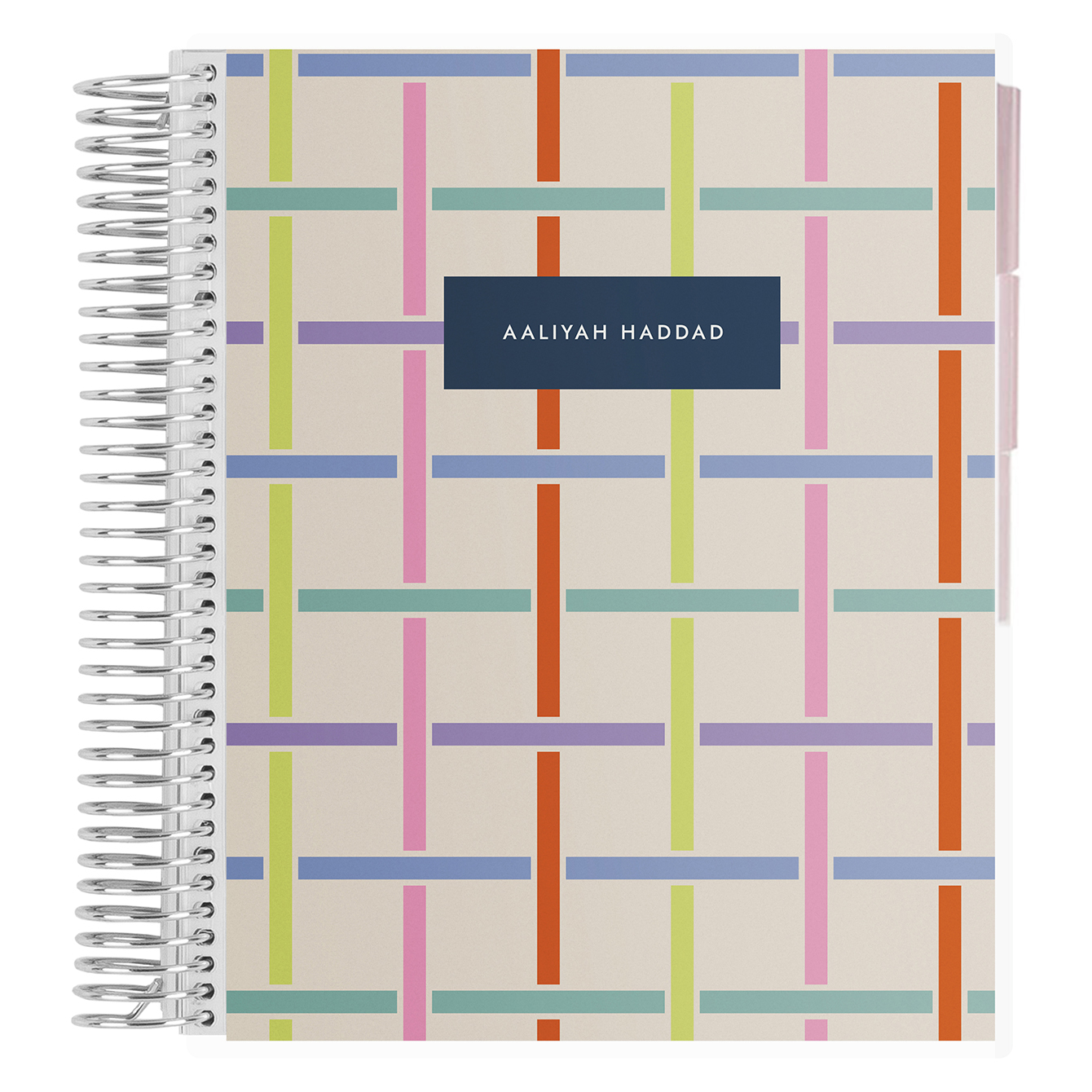The Power of Pen and Paper in the Age of AI

Why do people in the digital age still love journaling, writing notes, and planning on paper? That's a question we paper-lovers often ask. Despite technological advances, there's a timeless charm – and a host of benefits – to the tactile act of writing.
Amid digital noise, we find focus, clarity, and creativity in our notebooks. It's about simplicity and authenticity in a complex world. From memory enhancement to stress reduction, let's explore why this traditional method endures.
Writing Notes vs Typing Notes: Which Is Better?
Cognitive Engagement and Retention
Have you ever noticed that when you write by hand, you tend to slow down and process information more deeply? It’s a thing! And writing by hand can lead to better retention and understanding. Research has shown that the act of participants physically writing notes by hand engages different cognitive processes compared to typing on a laptop or computer keyboard. This phenomenon, known as the "generation effect," suggests that actively producing information by hand enhances participants' memory encoding and recall. Write on!
Creativity and Brain Stimulation
There's something just creative and stimulating about the tactile experience of writing with a pen on paper. Something about the fluid motion of forming letters (even sketches and doodles) can help you with brainstorming, problem-solving, and idea generation. Many of us find that we are more inspired and imaginative when we jot down our thoughts by hand, free from the distractions of digital interactions.
Potential for Distractions
Speaking of distractions, one of the downsides of digital note-taking is the constant interruption of thought, focus, and creativity (never mind decision fatigue!). With notifications popping up, emails arriving, and the allure of social media just a click away, it's easy for participants to lose focus during a laptop or computer note-taking session. Writing with pen and paper helps you unplug and cut through all that noise. With fewer distractions vying for your attention, you can stay more fully immersed and be more present to process, understand, retain, and recall the information in your handwritten notes.
This form of note-taking seems like it would take more time, but given all the advantages it has, it tends to save you time in the long run. Learn more about Mastering Time Management and Productivity.
Organization and Simplicity

While digital note-taking tools on a laptop or computer come with their own organizational features (such as folders, tags, and search functions), sometimes getting back to basics, like the simplicity of a physical notebook, leads to more effective note-taking. With pen and paper, you can easily flip through pages, make annotations, and create visual hierarchies without the need for complex software interfaces.
Do you need more everyday organization? Check out Seven Signs You Need a Paper Planner and 7 Classic Planner Layouts + Creative Ideas for Every Lifestyle.
Efficiency and Speed
Typing notes on a keyboard can certainly be faster than writing them out by hand, especially for individuals who are proficient typists. However, this speed comes at a cost—namely, the costly trade-off of depth and comprehension for speed.
While digital note-taking may be more efficient in terms of raw input speed, handwritten notes often lead to better understanding (especially when you have to organize the information in your head before writing only the important parts on paper).
As organization experts who are fans of handwritten note-taking and paper-based planners, we can attest to the efficiency and speed that the experience of using pen and paper provides. Writing by hand serves as a form of active engagement with the material, promoting deeper comprehension and retention.
Accessibility and Searchability
One of the primary advantages of digital note-taking for participants is the ability to access and search through your notes with ease. With a few keystrokes, you can instantly locate specific keywords or phrases within a library of digital documents. While handwritten notes lack this level of searchability, they offer their own form of accessibility—namely, the ability to be physically carried and referenced anywhere, without the need for electronic devices or an internet connection.
Battery and Device Dependency
Perhaps the most obvious drawback of digital note-taking for participants is its dependence on batteries and electronic devices. If your device runs out of power or malfunctions, you may find yourself unable to access your notes when you need them most. In contrast, pen and paper never run out of battery and are immune to technological failures, making them a reliable and enduring tool for capturing and preserving information.
Pen and Paper vs. AI for Students
For students, the choice between traditional pen and paper methods and the utilization of Artificial Intelligence (AI) tools presents a pivotal decision that can significantly impact learning outcomes in classes. Let's look at a comparative analysis of these two approaches in various educational contexts.
Learn How to Use Planner for School.
Handwriting in Lectures
Pen and Paper
For many students, the act of participants physically writing notes during lectures or classes has been a time-tested method for engagement and retention. Handwriting notes encourages active listening and processing of information, leading to enhanced comprehension and memory retention. Previous studies have shown that students who take handwritten notes tend to perform better on conceptual questions compared to their peers who type their notes.
AI Tools
AI-powered note-taking tools offer the convenience of quickly transcribing spoken words into digital text, eliminating the need for manual transcription. These tools can be particularly useful for students with disabilities or those who struggle with handwriting. However, some researchers suggest that typing notes on a keyboard may result in a shallower processing of information compared to handwriting, potentially leading to decreased retention and understanding.
Organization and Retrieval
Pen and Paper
While handwritten notes lack the searchability and organization features of digital tools, they offer a tactile and customizable organizational system. Students can easily annotate, highlight, and draw diagrams in their notebooks, creating a personalized study aid that reflects their unique learning style. However, finding specific information within handwritten notes may require manual scanning and flipping through pages.
AI Tools
AI-powered note-taking tools often come equipped with advanced search and organization capabilities, allowing students to quickly locate specific keywords or topics within their notes. These tools can automatically categorize and tag notes based on content, making it easier for students to review and study material efficiently. Additionally, AI tools may offer features such as text recognition and handwriting-to-text conversion, enabling students to digitize their handwritten notes for easier access and storage.
Interaction with Teachers
Pen and Paper
Handwritten notes provide a tangible artifact of the learning process that students can share and discuss with teachers and researchers after class. The physicality of pen and paper notes can facilitate deeper conversations and collaborations, allowing students to receive personalized feedback and guidance from educators. Additionally, handwritten notes may convey a sense of authenticity and effort that digital notes sometimes lack.
AI Tools
AI-powered note-taking tools offer the potential for seamless collaboration and communication between students, teachers, and researchers. These tools can facilitate real-time sharing and editing of notes, enabling students to collaborate on group projects or receive feedback from teachers remotely. Additionally, AI tools may provide insights and analytics on note-taking behavior, helping students and educators identify areas for improvement and optimization.
Here are 8 Proven College Organization Tips to Improve Productivity.
Tips for Effective Handwritten Notes

Use a Quality Notebook
When selecting a notebook, it's essential to consider factors such as paper quality, binding, size, and design. Opting for a notebook with high-quality paper ensures that your writing experience is smooth and comfortable, preventing ink bleed-through and feathering that can obscure your notes. Invest in a notebook that feels comfortable in your hand and has paper that suits your writing style.
Find the Best School Supplies for All Ages.
Develop a Shorthand
Shorthand involves using abbreviated symbols, abbreviations, or simplified writing techniques to condense complex ideas into concise notes. By mastering shorthand, you can significantly increase your note-taking speed while still preserving clarity and accuracy. Develop your own shorthand or abbreviations to help you capture information more quickly without sacrificing clarity.
Stay Organized
Effective note-taking goes beyond simply capturing information—it also involves organizing and structuring your notes in a way that facilitates comprehension, retrieval, and review. Maintaining organization in your handwritten notes can help you stay focused, identify key concepts, and make connections between different ideas more effectively. Use headings, bullet points, and numbering to organize your notes hierarchically and make them easier to review later.
Learn more about Checklists Plus Tips for Making Them.
Review and Revise
The process of note-taking for participants doesn't end when you put down your pen—it's equally important to review and revise your handwritten notes regularly to reinforce your understanding, identify areas for improvement, and ensure that your notes remain accurate and up-to-date. Set aside time to review and revise your handwritten notes regularly to reinforce your understanding and identify any areas that need clarification.
Learn how to use this review and revise method to improve your daily productivity with How to Use a Daily Planner + Tips.
Embrace Imperfection
When it comes to handwritten note-taking, perfection is not the goal—instead, focus on capturing the essence of the information and expressing your thoughts in a way that feels natural and authentic. Embracing imperfections in your notes can free you from the pressure of working towards flawless handwriting or pristine presentation, allowing you to focus on the content and meaning of your notes instead. Don't worry about making mistakes or having messy handwriting—your notes are for your eyes only, so focus on capturing the essence of the information rather than striving for perfection.
Striking a Balance: Hybrid Note-Taking

While handwritten notes offer numerous benefits for its participants, they're not without limitations. In an increasingly digital world, there are times when the convenience and functionality of digital note-taking tools are indispensable. Fortunately, you don't have to choose between one or the other—you can enjoy the best of both worlds by adopting a hybrid approach to note-taking.
By combining the strengths of pen and paper with the versatility of digital tools, you can create a note-taking process that's tailored to your preferences and workflow. For example, you might use a physical notebook for brainstorming and initial idea capture, then transfer your notes to a digital format for organization and long-term storage.
Alternatively, you could use a tablet or smartpen that allows you to write on paper while simultaneously digitizing your notes in real time.
You may also like How to Use Digital and Paper Planners Together.
Ultimately, the key is to find a balance that works for you—one that harnesses the unique advantages of both handwritten and digital note-taking methods to enhance your productivity, creativity, and learning.
The simple act of putting pen to paper remains a powerful tool for learning, creativity, and self-expression. While digital note-taking methods offer undeniable benefits in terms of efficiency and organization, handwritten notes provide unique advantages in terms of cognitive engagement, creativity, and reliability.
Whether you prefer the satisfaction of writing by hand or the convenience of digital technology, the most important thing is to find a note-taking method that suits your individual needs and preferences. By striking a balance between analog and digital tools, you can unlock new levels of productivity, insight, and inspiration in your personal and professional endeavors.
So, the next time you reach for your notebook or open your favorite note-taking app, remember the enduring power of pen and paper in the age of AI—and let your ideas flow freely, wherever they may lead.
Shop now. Pay in 4.
Always interest-free.
You must be over 18, a resident of the U.S. and meet additional eligibility criteria to qualify. Late fees may apply. Estimated payment amounts shown on product pages exclude taxes and shipping charges, which are added at checkout. Click here for complete terms. Loans to California residents made or arranged pursuant to a California Finance Lenders Law license.
© 2020 Afterpay
Pay in 4 interest-free payments
No impact on credit score and no late fees.
Available for purchases of $30 to $1,500.
Today
2 weeks
4 weeks
6 weeks
- Choose PayPal at checkout to pay later with Pay in 4.
- Complete your purchase with a 25% down payment.
- Use autopay for the rest of your payments. It's easy!
Pay in 4 is available to consumers upon approval for purchases of $30 to $1,500. Pay in 4 is currently not available to residents of MO or NVMissouri or Nevada. Offer availability depends on the merchant and also may not be available for certain recurring, subscription services. When applying, a soft credit check may be needed, but will not affect your credit score. You must be 18 years old or older to apply. PayPal, Inc.: Loans to CACalifornia residents are made or arranged pursuant to a CACalifornia Financing Law License. GAGeorgia Installment Lender Licensee, NMLS #910457. RIRhode Island Small Loan Lender Licensee. NMNew Mexico residents:
Find more disclosures related to Pay in 4.



